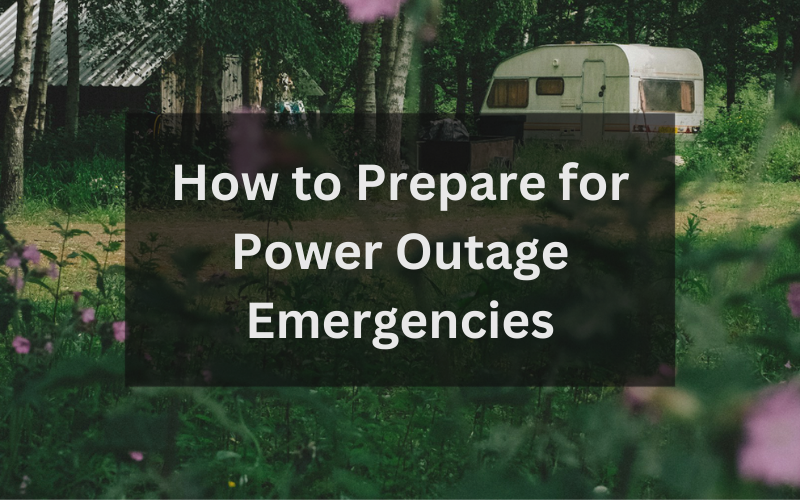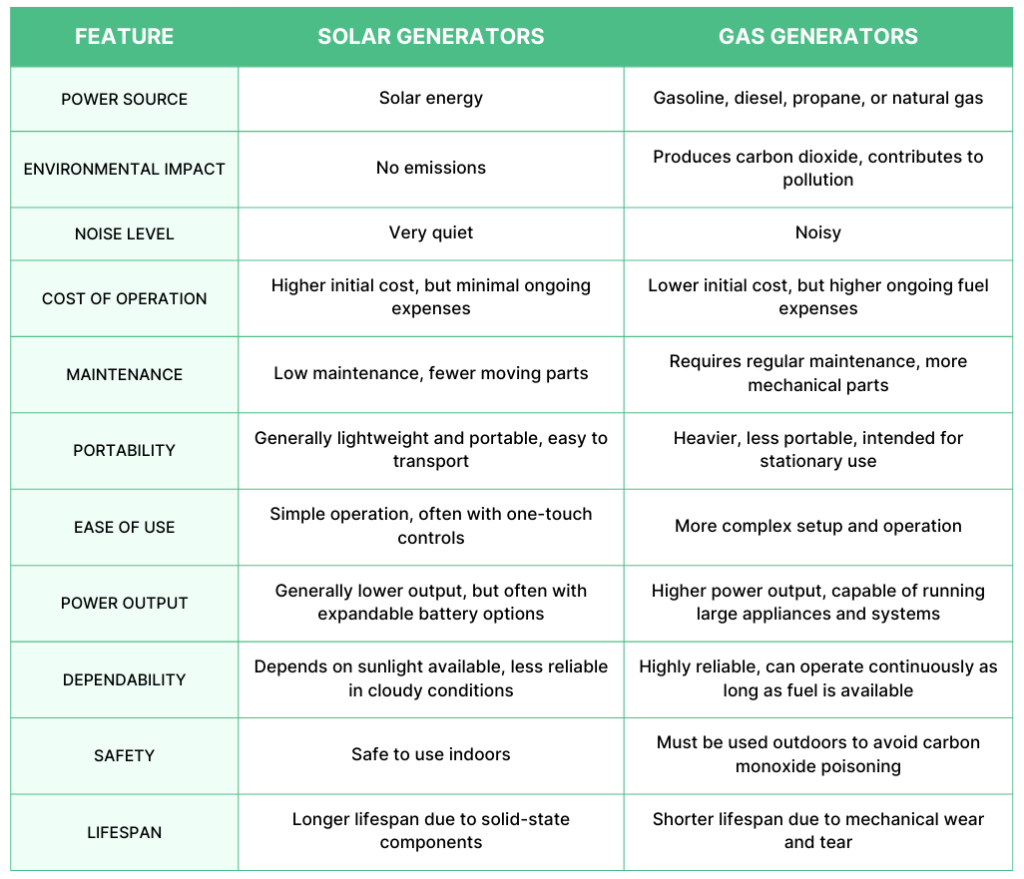Recent events have highlighted the vulnerability of our power grids to various disruptions, from extreme weather, to power supply shortages, to geopolitical instability. As a result, more people are recognizing the importance of being prepared for power outage emergencies, which can last from a few hours to several days.
This guide, using information sourced from ready.gov and the British and American Red Cross, provides straightforward, practical steps to prepare effectively, ensuring your safety and comfort until power is restored.
Why Prepare for Power Outages?
Power outages can occur with little to no warning, driven by various causes such as severe weather, technical failures, or maintenance issues. These outages can last from a few hours to several days, impacting everything from lighting and heating to communication and food preservation. Consequently, a lack of preparedness can lead to discomfort, and in severe cases, danger to health and safety.
The First Steps in Preparedness
Starting your preparations involves understanding the basics: what supplies you need, how to store them, and the initial actions to take when the power goes out. Simple measures, such as having a well-stocked emergency kit and knowing how to access information about the outage, can make a significant difference. Additionally, familiarizing yourself with manual tools and backup power options, like solar-powered devices, can enhance your readiness for when the electricity grid fails.
By the end of this guide, you will have a clear pathway to enhance your readiness for power outages. We will suggest specific strategies and tips to ensure you and your family remain safe and well-equipped during these incidents.
Table of Contents
Understanding the Risks of Power Outages
Common Causes of Power Outages
Power outages can be triggered by a variety of factors. Natural disasters such as hurricanes, tornadoes, and earthquakes often damage power lines and equipment. Severe weather conditions like ice, snow, and high winds can topple power lines or burden them with ice and snow, leading to widespread outages. Apart from weather-related causes, power outages can also result from human errors, equipment failures, or planned outages for maintenance that go awry.
Impacts on Daily Life
The immediate effect of a power outage is the loss of electrical lighting and the operation of appliances. This inconvenience can escalate quickly from a minor disruption to a critical threat, especially in extreme weather conditions. Heating and cooling systems cease to function, which can be dangerous during periods of extreme cold or heat.
Refrigeration failures lead to spoiled food, costing money and limiting your access to safe nutrition. Without power, essential medical devices cease to function, putting the health of individuals with medical needs at risk. Communication also becomes a challenge as phones, computers, and networks go offline, isolating individuals and complicating rescue and recovery efforts.
Safety Concerns
The longer a power outage lasts, the more severe the implications for safety. For example, lack of lighting increases the risk of accidents and injuries at home – however, alternative lighting sources like candles can pose fire hazards if not used cautiously. The absence of functioning security systems also makes homes more vulnerable to burglaries.
Basic Preparedness: Starting Small
Starting with Essentials
The best approach to preparing for power outages is to begin with the essentials for short durations, such as 24 to 72 hours. This initial focus ensures you can manage comfortably during most common outages without feeling overwhelmed by the need to prepare for more extended disruptions.
Essential Supplies
- Water: Store at least one gallon of water per person per day. This will cover drinking and sanitation needs.
- Food: Keep a supply of non-perishable food that requires no cooking. Items like canned goods, protein bars, and dried fruits are excellent choices.
- Light: Ensure you have multiple sources of light, such as flashlights and battery-powered lanterns. Avoid using candles to prevent fire hazards.
- Power: Portable chargers and extra batteries for your devices can keep you connected and informed.
- First aid kits: Have a basic first aid kit that includes items such as bandages, antiseptics, and over-the-counter medications.
Creating a Basic Emergency Kit
An emergency kit tailored for short-term outages should be compact and ready to use. Besides the items listed above, include personal items like extra clothing, blankets, and essential documents stored in waterproof containers.
Practical Steps to Take
- Educate everyone in the household: Make sure all family members know where the emergency supplies are kept and understand basic safety practices during an outage.
- Keep supplies accessible: Store your emergency kit in a designated place that is easy to access in the dark.
- Regularly update and rotate supplies: Check your kit every six months, replace expired items, and replenish used supplies.
Starting small not only makes the task of preparing less daunting, but also puts you in a better position to handle unexpected power outages with confidence, should they arise.
Food Storage and Management
Safe and Efficient Food Storage
Storing food safely and efficiently is critical during a power outage to ensure that your supplies remain both edible and nutritious. Here are key strategies to optimize your food storage:
- Choose the right foods: Focus on non-perishable items that require minimal or no preparation, such as canned vegetables, beans, fruits, and meats. These foods provide essential nutrients and have long shelf lives.
- Proper packaging: Store food in tight, waterproof containers to protect against moisture and pests. This is especially important in areas prone to humidity or insects.
- Cool, dry storage: Keep your food supplies in a cool, dry place. A basement or a closet away from direct sunlight is ideal to prevent spoilage.
- Organization: Arrange your supplies in a way that older items are in front and new purchases go to the back. This practice, known as “first in, first out,” helps rotate supplies and prevents wastage.
Building a Sustainable Food Supply
Creating a sustainable supply of food requires thoughtful planning and rotation. Here’s how you can build and maintain a supply that can last for an extended period:
- Start small, scale up: Begin by accumulating enough food to last your household for three days, then gradually increase your stockpile to last a week, two weeks, or even a month.
- Diversity of food: Include a variety of food types to avoid monotony and ensure balanced nutrition. Grains, proteins, fruits, and vegetables should all be part of your pantry.
- Regular checks: Regularly inspect your stock for expiration dates and signs of spoilage. Replace items as needed, and use supplies nearing their expiration in your daily cooking to ensure they don’t go to waste.
- Meal planning: Plan meals around your stored food to become familiar with using these items in your regular cooking routine. This practice will make it easier to adjust to using these foods during an outage.
- Long-term options: For extended preparedness, consider bulk food storage solutions such as freeze-dried meals or meals ready to eat (MREs), which can last for years without spoiling.
Water Storage Solutions
How Much Water to Store
One of the most critical components of emergency preparedness is water storage. Each person in your household should have at least one gallon of water per day for drinking and sanitation. For a standard three-day emergency kit, this means storing at least three gallons of water per person. However, in hotter climates or in situations where increased physical activity is necessary, more water may be required.
Safe Water Storage Practices
Storing water safely ensures its availability and potability when needed. Here are some best practices for water storage:
- Use appropriate containers: Only use containers made for water storage, such as those made from food-grade plastic or glass. These containers should be clean, airtight, and labeled with the storage date. Avoid containers that have previously held chemicals or toxic substances.
- Proper location: Store water in a cool, dark place away from direct sunlight and heat sources, which can promote algae and bacteria growth. Basements or closets are ideal locations.
- Regular rotation: Water should be rotated every six months to maintain freshness. If you’re using commercial bottled water, adhere to the expiration date provided by the manufacturer.
- Large volume storage: For extended emergencies, consider larger storage options like 55-gallon barrels. These barrels should be placed on wooden pallets to prevent contact with concrete and ensure the integrity of the container.
- Accessibility: Ensure that water is easily accessible during an emergency. Keep a hand pump or siphon available if using large barrels, and always have a backup plan for accessing water if your primary storage becomes compromised.
Additional Tips
- Water treatment: In cases where stored water might be compromised or if you need to use water from natural sources, have a reliable method of water treatment. Boiling, chemical purifiers, and filtration systems are effective options.
- Special needs: Consider the needs of pets, plants, and any medical conditions that require additional water.
Lighting Setups
Options for Essential Lighting
During a power outage, maintaining adequate lighting is crucial for safety and comfort. Here are several reliable lighting options that can be used when the power goes out:
- Battery-operated lights: Flashlights and battery-operated lanterns are indispensable during a power outage. Ensure you have a good supply of batteries and test your lights regularly.
- Solar-powered lights: Solar lights are a sustainable option that can be recharged during the day to provide illumination at night. They come in various forms including lanterns, path lights, and even string lights for larger areas.
- Manual lights: Crank flashlights or lanterns that don’t require batteries can be powered by manual effort. These are especially valuable in situations where battery power might be conserved for other uses.
Lighting Placement
- Room-by-room: Assign specific lights to each room to avoid moving them around. This ensures that every area has a dedicated light source if needed.
- Emergency kits: Include a portable light source in every emergency kit, ensuring that you can quickly grab a light along with other essentials.
- Path lighting: Set up solar path lights leading to and from essential areas like the bathroom or kitchen to safely navigate your home in the dark.
Advanced Lighting Tips
- Reflective surfaces: Use mirrors or other reflective surfaces to enhance light distribution throughout a room. This method helps maximize the light output of a single source.
- Long-lasting LED: Opt for LED lights, which consume less power and last longer than traditional bulbs. This will extend the life of your batteries and reduce the need for replacements.
- Backup systems: For those with greater lighting needs or larger areas to cover, consider investing in a backup power system that includes a solar-charged battery pack specifically for powering lighting.
Maintaining Communication
Importance of Communication During Outages
Staying connected during a power outage is vital for receiving updates about the situation, reaching out to emergency services if needed, and maintaining contact with family and friends. Here are several methods to ensure effective communication even when the power is down.
Keeping Devices Charged
- Battery backups: Portable power banks are essential for keeping mobile phones and other small electronic devices charged. Opt for high-capacity power banks that can provide multiple charges before needing a recharge themselves.
- Solar chargers: Solar-powered chargers are valuable for their ability to recharge devices using sunlight. They come in various sizes, some suitable for charging mobile phones, while others can handle larger devices like tablets.
- Car chargers: Keep a car charger handy as a backup charging option. This allows you to charge devices using your vehicle’s battery. Be cautious to run the vehicle periodically to avoid draining the car’s battery.
Communication Strategies
- SMS and text alerts: During a power outage, text messages may be more reliable than voice calls due to lower bandwidth usage. Sign up for local alerts and communicate with family through SMS to conserve battery life.
- Emergency radios: A battery-operated or hand-crank emergency radio can provide important local information when traditional media outlets are unavailable. Some models also include built-in chargers for small devices.
- Backup communication plans: Establish a family communication plan that includes meeting points and alternate ways of staying in touch if the cellular network goes down. Consider using apps that can send messages without a mobile network, relying on Bluetooth or local WiFi.
Preparing for Extended Outages
For longer-term power outages, consider additional measures such as:
- Satellite phones: For those in remote areas or where cell service is unreliable, a satellite phone can be a critical tool for maintaining communication.
- Two-way radios: Walkie-talkies or other two-way radios can facilitate short-range communication between family members or neighbors without relying on cellular networks.
Home Heating and Cooling Strategies
Managing Temperature Extremes During Outages
Power outages can disrupt your home’s heating and cooling systems, making it uncomfortable or even dangerous, especially during extreme weather. Here are some effective strategies to manage indoor temperatures without traditional HVAC systems during a power outage.
Keeping Warm Without Power
- Insulation and sealing: Prioritize keeping heat inside by insulating windows and doors. Use draft stoppers and heavy curtains to reduce heat loss. Seal any cracks or gaps with weather stripping.
- Layered clothing: Dress in multiple layers of clothing to retain body heat. Use thermal wear, hats, gloves, and thick socks.
- Space heaters: If you have a generator, use a portable space heater in small, confined areas. Never leave heaters unattended and ensure there is proper ventilation to prevent carbon monoxide poisoning.
- Sleeping arrangements: Sleep in a central room where everyone can share body heat. Use sleeping bags and blankets designed for low temperatures.
- Temporary heat sources: Use safe, indoor propane heaters or wood stoves if you have them. Always follow safety instructions and keep a carbon monoxide detector active.
Staying Cool Without Power
- Block out the sun: Keep blinds or curtains closed during the day to block out solar heat. Use reflective materials on windows facing direct sunlight.
- Natural ventilation: Open windows during cooler parts of the day to create cross-ventilation. Use window fans if available to circulate air.
- Cooling cloths and baths: Use damp towels or cooling cloths on your neck and wrists. Take cool showers or baths to reduce body temperature.
- Stay hydrated: Drink plenty of water to stay hydrated. Avoid alcohol and caffeine as they can dehydrate you.
- Use battery-powered fans: Have battery or solar-powered fans on hand to help circulate air and make the environment feel cooler.
Preparing for Temperature Extremes
- Monitor weather forecasts: Stay informed about upcoming weather conditions to prepare accordingly for a power outage.
- Invest in renewable energy solutions: Consider installing solar panels or a solar-powered ventilation system that can provide cooling or power small heaters.
Cooking Without Power
Overview of Power-Free Cooking Options
When a power outage strikes, being able to prepare meals safely and efficiently becomes a crucial survival skill. Here are some reliable methods to cook food without relying on traditional power sources.
Utilizing Alternative Cooking Devices
- Butane stove: Compact and easy to store, butane stoves are ideal for short-term emergencies. They require butane cartridges, which are easy to use and store. Ensure you cook in a well-ventilated area to avoid any risk of carbon monoxide buildup.
- Propane stove: More robust than butane stoves, propane stoves come in various sizes and can be used for everything from boiling water to cooking full meals. Like with butane, ventilation is crucial, and it’s important to check that your propane stove is suitable for indoor use.
- Solar cooker: Utilizing the sun’s power, solar cookers can heat, boil, and bake without any fuel. They are most effective on sunny days and require no other energy source, making them a sustainable option during prolonged outages.
- Rocket stove: Efficient with fuel and capable of reaching high temperatures with just small pieces of wood, rocket stoves are a great emergency cooking tool. They are designed to produce minimal smoke and can be used outdoors.
Safe Cooking Practices
- Always monitor cooking: Never leave your alternative cooking devices unattended. Continuous monitoring ensures safety and helps prevent accidents.
- Use carbon monoxide detectors: When using gas-powered stoves, always have a functioning carbon monoxide detector in the area, as these stoves can emit harmful gases.
- Prepare outdoor cooking options: Whenever possible, set up your cooking station outdoors to ensure proper ventilation and reduce indoor air quality issues.
Preparing Food Supplies
- Pre-cooked, non-perishable foods: Stock up on foods that require minimal preparation, such as canned soups, beans, and ready-to-eat meals. These can be easily heated or eaten cold if necessary.
- Dry goods: Keep a good supply of rice, pasta, and lentils, which can be cooked with just boiling water. These staples have long shelf lives and can provide the basis for nutritious meals. Make sure they are sealed properly after opening to prevent things like weevils from getting in (a plea from someone with first-hand experience of a weevil infestation – they get everywhere).
- Practice and prepare: Familiarize yourself with your cooking equipment before an emergency strikes. Practice cooking with these alternative methods to ensure you are prepared to use them effectively during a power outage.
Renewable Power Options: Solar Generators vs. Gas Generators
When a power outage occurs, having a generator can make a significant difference in maintaining essential functions in your home. There are two primary types to consider: solar generators, and gas generators. Each has its own set of benefits and limitations, and the choice depends on your needs, environmental considerations, and preference for convenience.
Solar Generators
Solar generators (i.e. portable power stations with solar panels) are an eco-friendly alternative to traditional gas generators. They operate silently, with zero emissions, making them ideal for both indoor and outdoor use. Here are some of the key advantages:
- Eco-friendly: Solar generators produce clean energy, without the carbon dioxide emissions associated with gas generators. This makes them a sustainable choice for environmentally conscious users.
- Economic: Once the initial investment is made, solar generators incur no ongoing fuel costs. The sun provides free energy, reducing long-term expenses. Even though the sun isn’t shining for 24 hours a day, the internal battery stores energy for later use.
- Quiet operation: Unlike gas generators, solar generators run quietly, typically around 7dB at 7 meters, which is a mere whisper in comparison.
- Portability: They are generally lightweight and designed for easy transport, making solar generators versatile for both home use and outdoor activities like camping.
- Ease of use: With most models offering a simple, one-touch operation, solar generators require minimal setup and maintenance, providing a user-friendly experience.
For more information, including how to choose the best solar generator for your setup, see our guide on Incorporating Solar Energy into Off-Grid Living, or the Best Portable Power Stations of 2024.
Gas Generators
Gas generators are popular for their reliability and high power output. They are suitable for a range of applications, from residential to commercial.
They have earned their popularity largely due to their powerful output and immediate readiness. They can generate a significant amount of electricity on demand, which is essential for running large appliances and systems in homes and businesses during outages. Additionally, the widespread availability of gasoline and the familiarity of the technology make them a go-to choice for many seeking a reliable power backup solution.
Despite their popularity, they come with considerations to keep in mind:
- Air pollution: Burning gas or oil, these generators emit carbon dioxide, contributing to air pollution and having a larger carbon footprint.
- Ongoing costs: Operating a gas generator requires a continuous supply of fuel, which can add up in cost, especially during extended outages.
- Noise levels: Gas generators are significantly louder, with noise levels around 57dB at 7 meters, which can be disruptive for both the user and the surrounding community.
- Weight and size: Typically heavier, gas generators are better suited for stationary home use rather than for carrying to different locations.
- Setup: They often require more complex setup and maintenance, which can be a drawback for those looking for ease of use.
When selecting a generator, consider how often and for how long you experience power outages, the appliances you need to run, and your commitment to environmental sustainability. Solar generators offer a clean, quiet, and user-friendly option, aligning with the growing shift towards renewable energy solutions, while gas generators provide a traditional, powerful solution for immediate and high-energy demands.
Using Gas Generators Safely
If you do opt for using a gas generator for power outage emergencies, whether as your sole generator or in conjunction with your solar generator, it is crucial you are equipped with the knowledge required for safe operation.
Choosing the Right Gas Generator
- Type of generator: Portable generators are commonly used for temporary power solutions and are ideal for running essential appliances like refrigerators, lights, and heaters. Standby generators, on the other hand, are permanently installed and automatically start when power goes out.
- Fuel type: Generators run on various fuels such as gasoline, diesel, propane, or natural gas. Each has its advantages and limitations. Gasoline is widely available but stores poorly; diesel offers longer run times; propane and natural gas have longer shelf lives and are cleaner burning.
Tips on Operating Generators Safely
- Carbon monoxide poisoning prevention: Always operate generators outdoors, away from windows, doors, and vents to prevent exhaust fumes from entering the home. Carbon monoxide (CO) is odorless and colorless, and can lead to serious health issues or death if inhaled.
- Proper ventilation: Ensure the generator has plenty of space for air circulation to prevent overheating and reduce CO buildup.
- Electrical safety: Never plug a generator directly into your home’s wiring unless a transfer switch has been installed by a professional. Plugging a generator directly into a wall outlet can cause backfeeding along power lines and pose a serious threat to you, your property, and utility workers.
- Grounding: Make sure the generator is properly grounded to avoid electrical shocks and fire hazards.
- Fuel handling: Store fuel for the generator in properly labeled, non-glass safety containers. Use a funnel to avoid spills when refueling and never refuel a running or hot generator. Wait for it to cool down first to prevent fires.
- Regular maintenance: Regularly check and maintain your generator according to the manufacturer’s instructions. Inspection should include checking oil levels, cleaning air filters, and ensuring the equipment is in good working order.
Preparing for Extended Use
- Run time and capacity: Understand how long your generator can run on a full tank of fuel and what its capacity is to ensure it meets your needs during an outage.
- Noise considerations: Be aware of the noise level of your generator and consider neighbors, especially in dense residential areas. Noise barriers or choosing a quieter model can help maintain good relations with those around you.
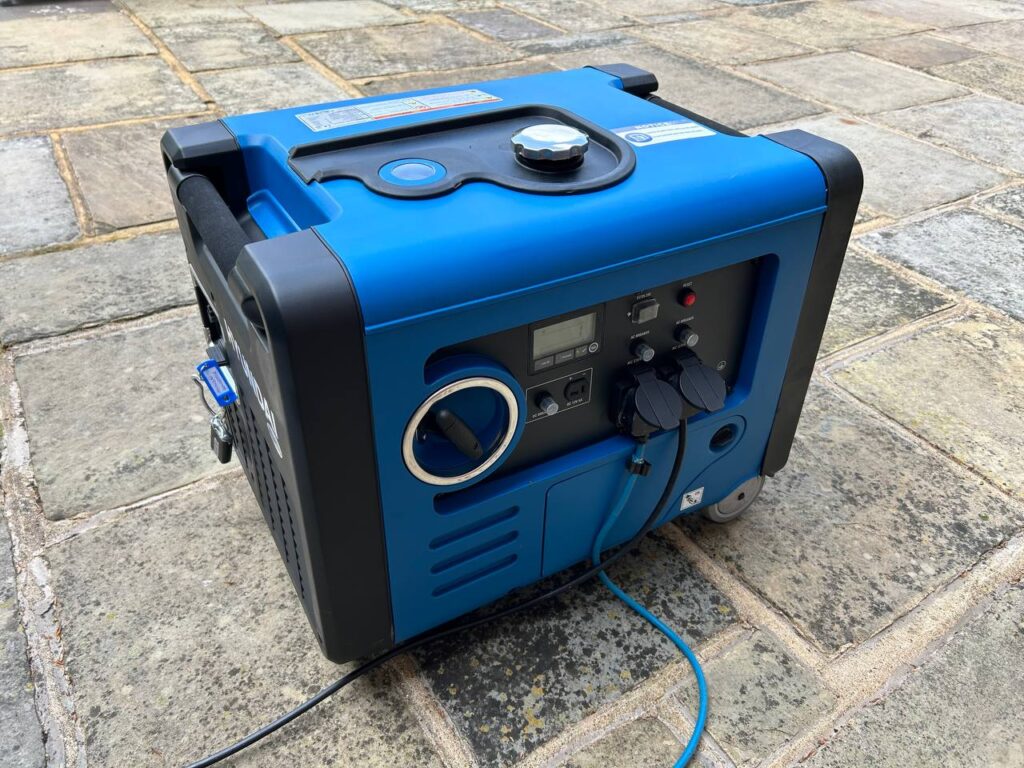
Health and Safety: First Aid and Medical Needs
Building a Comprehensive First Aid Kit
A well-stocked first aid kit is a cornerstone of any emergency preparedness plan. Here’s a suggestion of what to include to ensure you can address most common injuries and medical needs:
- Bandages and dressings: Various sizes of adhesive bandages bandaids, sterile gauze pads, and rolls for dressing wounds.
- Antiseptics: Antibacterial ointments and antiseptic wipes for cleaning cuts and abrasions; essential for preventing infections.
- Cotton wool products: Cotton pads, balls, and swabs for cleaning wounds with antiseptic.
- Medical tools: Scissors, tweezers, and a thermometer (to test for infection or illness).
- Pain relievers: Over-the-counter pain medication such as ibuprofen or paracetamol.
- Allergy medications: Antihistamines for allergic reactions.
- Personal medications: A supply of prescription medications for those with chronic conditions.
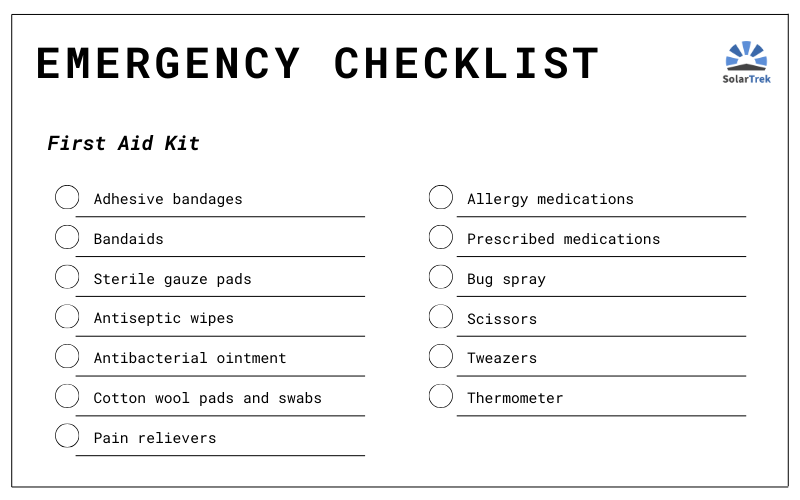
Managing Medical Devices During Power Outages
For those dependent on power for medical devices, a power outage can be particularly challenging. Here’s how to manage these needs safely:
- Backup power: Keep backup batteries or a power bank specifically for medical devices. For devices that require more power, a generator may be necessary.
- Manual alternatives: Whenever possible, have a manual alternative for your device. For example, a manual wheelchair can substitute an electric one in case of power failure.
- Plan with providers: Discuss a power outage plan with your healthcare provider for devices like oxygen concentrators or dialysis machines.
- Emergency information: Keep a list of model numbers, operating instructions, and provider contact information with your medical devices.
Emergency Action for Power-Dependent Medical Needs
- Medication storage: For medications requiring refrigeration, have a cooler and ice packs available as a temporary solution. A thermometer inside the cooler will help monitor the temperature to ensure medications stay within a safe range.
- Emergency services: Know the location of the nearest hospital or emergency service capable of providing power for your medical needs.
- Regular check-ups: Ensure that devices are in good working order and that you’re familiar with their manual operation if applicable.
Remember that the first aid kit should be easily accessible, and all household members should be familiar with its contents and use, as well as where it is kept.
In the following section, we will discuss the importance of creating and managing an emergency kit tailored for various situations such as home, car, and portable needs.
Building and Managing an Emergency Kit
Having a well-prepared emergency kit can make a substantial difference in your comfort and survival during a power outage. Different situations call for varied types of kits: we suggest preparing one for the home, another for your vehicle, and a portable version you can take with you if you need to leave quickly.
Home Emergency Kit Essentials
Your home emergency kit should be comprehensive, covering all the basics needs for at least 72 hours:
- Water: One gallon per person per day for drinking and sanitation.
- Food: A supply of non-perishable food items and a manual can opener.
- Lighting: Flashlights, extra batteries, and solar-powered lamps.
- First aid kit: As previously detailed, with personal medications included. Mosquito or bug spray is also a good idea to keep with medication and sanitary items.
- Tissues: Make sure you have enough tissues and toilet roll if you are unable to get to convenience stores.
- Tools: Multi-tool, duct tape, and basic repair items.
- Communication devices: A battery-powered or hand-crank radio and a fully charged power bank for mobile phones.
- Sanitation: Moist towelettes, hand sanitizer, garbage bags, and plastic ties for personal sanitation.
- Important documents: Copies of personal documents (ID, insurance policies, etc.) in a waterproof container.
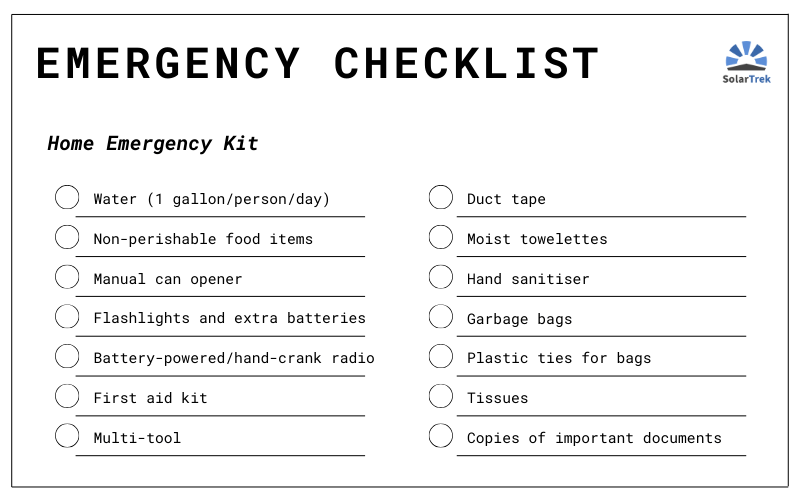
Car Emergency Kit Components
Your car kit should contain items necessary for roadside emergencies, as well as catering to the possibility of being stranded:
- Blankets or sleeping bags: Compact and heat-retaining materials for warmth.
- Food and water: Non-perishable snacks and water bottles.
- First aid kit: A smaller, portable version of your home kit.
- Lighting: A flashlight with extra batteries or a hand-crank version.
- Tools: Jumper cables, tire repair kit, and basic hand tools.
- Winter gear: Additional items like an ice scraper, snow shovel, and cat litter or sand for traction if in a snowy region.
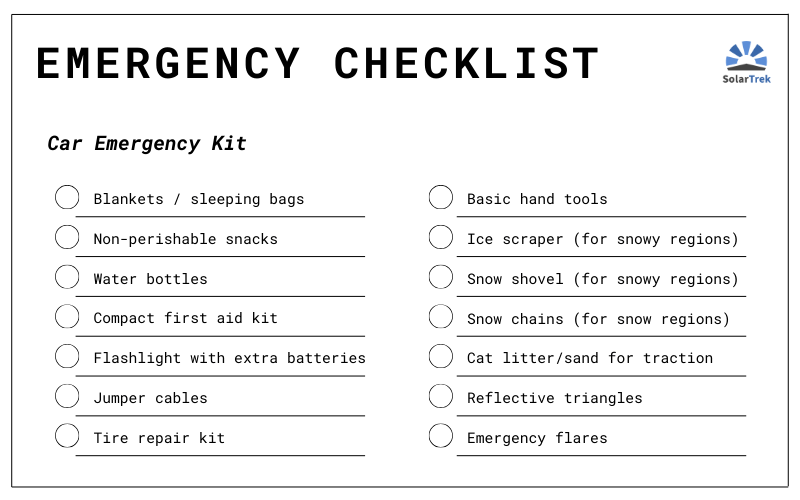
Portable Emergency Kit for Evacuation
This is a grab-and-go bag, that should be lightweight and filled with essentials:
- Water bottles and purification supplies: Portable filtration devices or purification tablets.
- Emergency food: Energy bars, ready-to-eat meals, and dried fruits.
- First aid supplies: Basic first aid kit with necessary personal medications.
- Clothing: A change of clothing appropriate for the weather and sturdy shoes.
- Cash: Small bills and coins can be crucial if ATMs and credit card systems are down.
- Personal items: Extra glasses, hygiene supplies, and a whistle for signaling.
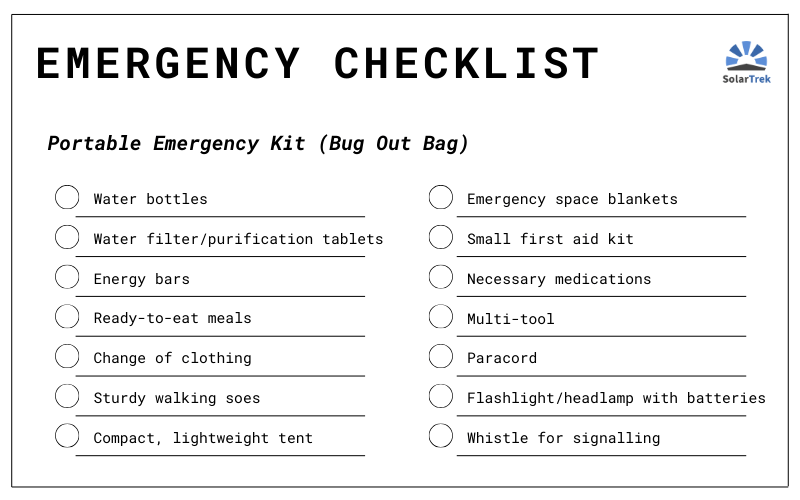
Kit Management and Maintenance
- Regular checks: Inspect your kits biannually. Check expiration dates on food, water, batteries, and medication, and replace any used or outdated items.
- Familiarity: Make sure all family members know where the kits are stored, and have a basic understanding of how to use the contents.
- Customization: Tailor the kits to the specific needs of your family, including items for infants, elderly members, or pets.
A well-built and maintained emergency kit can be your lifeline in the critical moments and days following a power outage.
Planning for Evacuation
When a power outage is accompanied by a more severe emergency that requires you to leave your home, having an evacuation plan and a ready-to-go “bug out” bag is essential. Here’s how to ensure you’re prepared for a quick departure.
Bug Out Bags: The Essentials
A “bug out bag” is a portable kit that contains the items one would require to survive for 72 hours when evacuating from a disaster. It should include:
- Water and filtration: Water bottles and a portable water filter or purification tablets.
- Food: High-energy, non-perishable food items like energy bars and trail mix.
- Clothing: A change of clothing appropriate for the climate and sturdy walking shoes.
- Shelter: Compact, lightweight tent or emergency space blankets.
- First aid kit: As previously detailed, tailored for portability.
- Tools: A multi-tool, paracord, and a compact flashlight or headlamp with extra batteries.
Evacuation Routes and Meeting Points
- Identify multiple routes: Have several predetermined routes out of your area in case the primary route is inaccessible.
- Meeting points: Establish meeting points outside of your immediate neighborhood if family members are separated.
- Map it out: Keep physical maps in your bug out bags and vehicles in case digital navigation systems are down.
Practice and Communication
- Drills: Conduct regular evacuation drills with your family so everyone knows what to do and where to go.
- Communication plan: Have a plan for how to communicate with family members if you get separated. This might include a check-in procedure with an out-of-town contact.
- Pet preparedness: Include your pets in the plan with their own supplies and consider their transportation needs.
Staying Informed
- Emergency alerts: Sign up for local emergency alerts to receive real-time information about evacuation orders.
- Neighborhood plan: Participate in community emergency preparedness programs to understand the broader plan for your area.
Being prepared with a detailed evacuation plan, a well-packed bug out bag, and routes that are familiar to all family members can significantly reduce the stress and chaos in the event of an emergency.
Community and Family Preparedness
In times of emergency, the support of a community and the preparedness of each family member are invaluable. The community aspect is particularly important if your local area is susceptible to emergencies such as natural disasters. Here’s how to strengthen these critical relationships and ensure collective readiness.
Building a Supportive Community
- Engage with neighbors: Get to know your neighbors and discuss shared concerns and resources. Consider creating a neighborhood contact list for emergencies.
- Community meetings: Attend or organize community meetings to plan for widespread emergencies and power outages. This is a time to share skills, resources, and plans.
- Local resources: Know where to find community shelters, medical centers, and emergency assistance services.
Inclusive Family Planning
- Clear communication: Make sure every family member understands the emergency plan. Tailor explanations to be age-appropriate so that even children can understand their role.
- Assign responsibilities: Assign tasks based on each person’s abilities. Someone might be responsible for grabbing the emergency kit, while another is tasked with ensuring pets are ready to evacuate.
- Practice runs: Regularly conduct practice drills to reinforce the plan and make it second nature. Include drills for both staying at home and evacuating.
Special Considerations for Vulnerable Family Members
- Special needs: Account for family members with special needs, including additional supplies or specific medications.
- Elderly care: Create a plan that considers the mobility and health requirements of older adults.
- Children’s needs: Include children in the planning process and prepare them through education and role-playing to help reduce their anxiety during actual emergencies.
Strengthening Community Ties
- Skill sharing: Offer to share your own skills (like first aid or amateur radio operation) and learn from others who have different skills that can be beneficial in emergencies.
- Resource pooling: Discuss with your community the potential for pooling resources like generators, tools, and other essential supplies.
Conclusion
As we reach the end of our guide on emergency preparedness for power outages, it’s important to emphasize that preparedness is not a one-time effort, but should be an ongoing process.
The Importance of Staying Updated
- Review kits and plans: Schedule biannual reviews of your emergency kits and plans to ensure supplies are fresh, functional, and that your plan accommodates any changes in your family’s situation.
- Stay informed: Keep up with the latest in emergency preparedness by staying informed about new technologies, resources, and community planning efforts.
We hope this guide was helpful. There is a wealth of knowledge and resources online which can help you prepare for the worst-case scenarios – YouTube is a great resource for finding tips related to specific scenarios or circumstances.
Remember, the time invested in preparing today can significantly reduce the impact of a power outage tomorrow, ensuring the safety and comfort of you and your loved ones. Stay prepared, stay safe, and stay connected.


